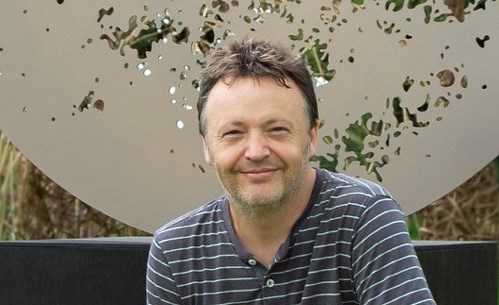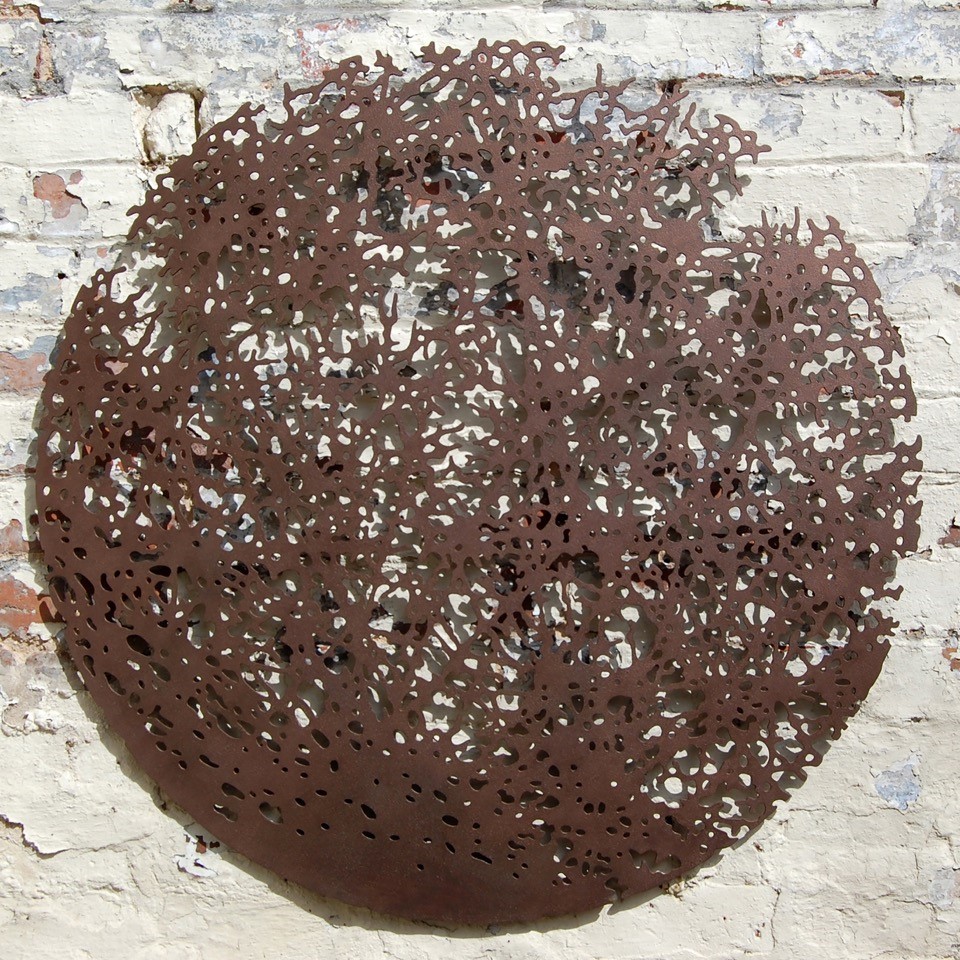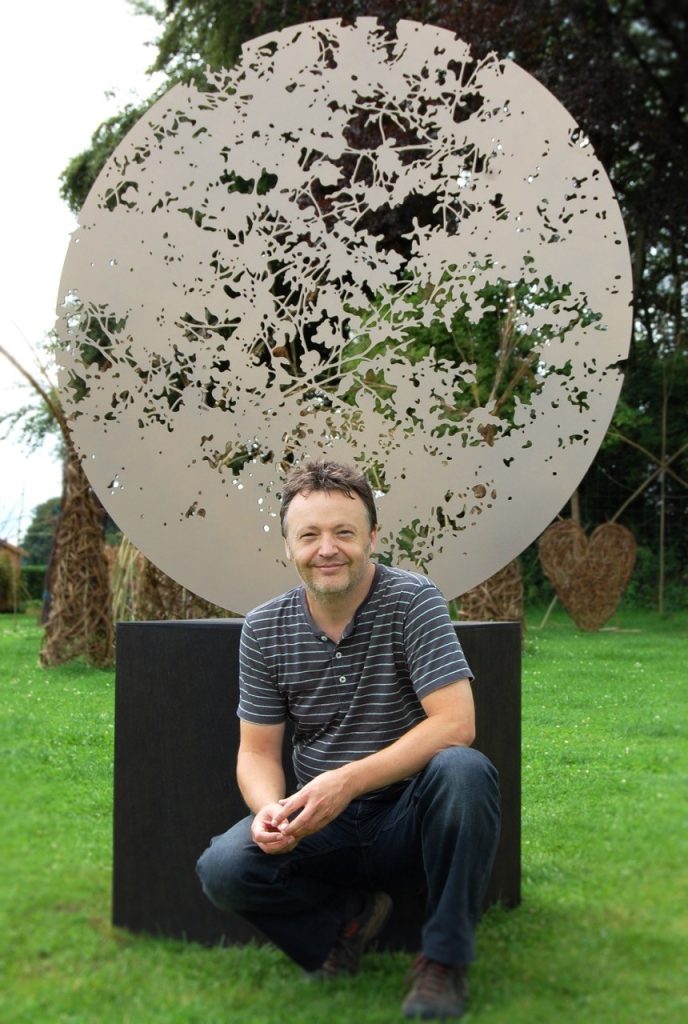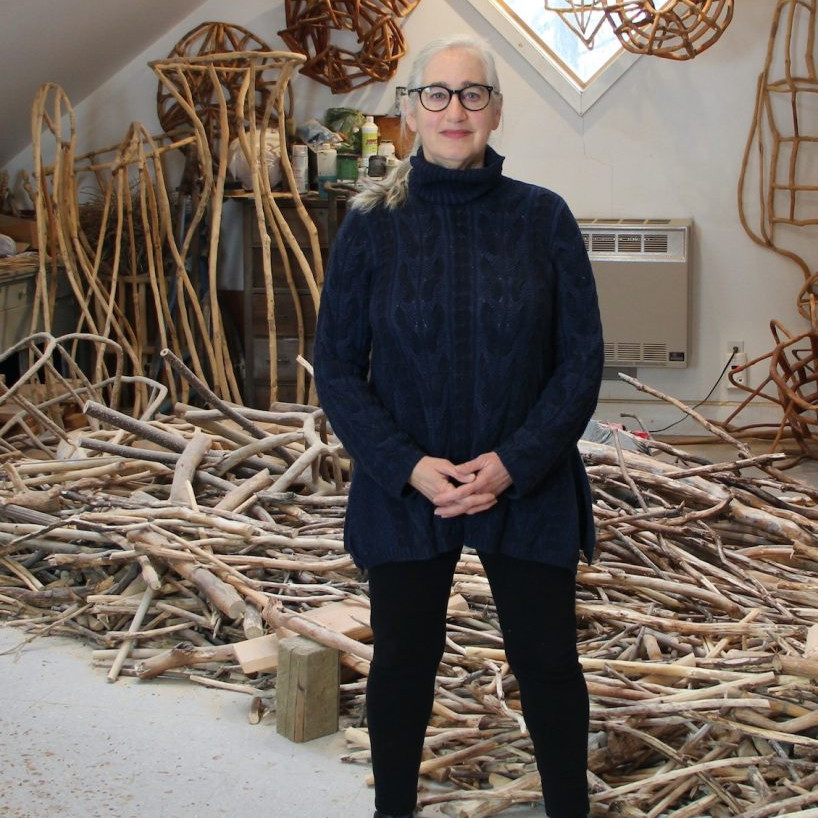Ian Turnock Sculpture - Cheshire, UK
“Drawings and photographs are the starting point from which I develop organic, abstract and figurative forms.” Please expand on this?
I take photographs of leaf and branch forms, usually silhouetted against the sky. These are shapes and structures that change with the seasons from lush new growth in the summer to fine winter branches. I then use the images as the starting point for digital drawings, selecting areas of the images to develop, exploring things such as the delicacy of linear branch patterns to the bold positive and negative spaces created by leaves. Sometimes the drawings are representational but I also create new forms which although abstract still convey a sense of the natural world. I draw, edit, overlay, and redraw often in very fine detail until I am happy with all the compositional elements.
Above the Trees, 11.95 cms, weathered and waxed reclaimed steel
You use many different materials stainless steel, aluminium, copper, reclaimed steel and plywood can you take 2 and discuss your decision to use the specific material.
Copper is probably the most ‘organic’ of the metals I use. It will naturally change over time creating a mottled verdi gris surface, but it can also be patinated to create a range of colours. Currently I do this using basic ingredients such as salt and Copper Sulphate to weather it. The surface can be protected with oils and waxes to slow down future patination. It is a fairly soft metal with a very natural look and feel that contrasts beautifully with the precision of the cut edges. Stainless steel is very different in that is a very hard, weather resistant metal that maintains it’s appearance over time. Although a very tough material when cut and polished it can appear very delicate, with a shimmering, light reflective surface.
Shadowplay, 1.2 m, Corten weathered steel
What are some of the issues you have to take into account when making outdoor sculpture?
The two metals discussed show one of the issues to be taken into account. Stainless steel in particular is useful for public projects where a tough, low maintenance material is needed, but in contrast I have made a copper piece for a private garden because the client wanted to see it change over time. I also need to consider where the sculpture will be sited and what fixings will be needed to secure it.
How large are some of your works?
The largest piece I have made so far is a 2m diameter wall sculpture for the Whiteleaf Centre, a new mental health hospital in Aylesbury, UK.
Many of your sculptures are for gardens, discuss your relationship with gardens and landscaped gardens and the importance a piece of sculpture can be to the completion of a given space?
Most of my work so far has been wall mounted rather than free standing, so quite different to more traditional garden sculpture such as a plinth based statues. Sculpture creates a focal point for a garden or landscape and I think this particularly applies in more minimal contemporary designed gardens that I have made work for. It can compliment or contrast with both natural and man made elements.
Eye of the Hurricane, 1.3 m, powder coated aluminium
Landscape design and gardening are great generators for current day sculptors discuss the importance of this to your practice.
I would like to make more work for gardens and to work with garden designers from the start of a project. So far, most of my work has been for interiors, but I am currently trying to develop some new pieces for outdoor settings.
Awakening, 1.1 m, stainless steel
Discuss the work you made for both the two RHS flower shows Hampton Court Flower Show and RHS Chelsea Flower Show where you represented One Church Street Gallery.
The brief
The pieces
One Church Street gave me a lot of creative freedom. For the first Chelsea Show the work was from a series inspired by trees and branches, such as ‘Above us the Trees’ and also very dynamic and abstract works such as ‘Eye of the Hurricane’ and ‘Spindrift’. For the subsequent shows I made some new sculptures with a more floral influence, such as ‘Sundance’ and ‘Ostara’.
Shelter from the Sky, 1.5 m, powder coated aluminium
Discuss how you work in both 3D and 2D?
My work so far has been 2D, cut from flat sheets, but I am currently looking at ways of developing 3D pieces. This is challenging as it involves learning new drawing software and finding the right technologies to actually make what I have drawn – watch this space!
Eye of the Hurricane 1.3 m, powder coated aluminium
You also do woodcuts discuss the technique you use. These woodcuts are limited editions, how many do you limit them to?
The woodcuts are also laser cut, using a different type of laser than is used to cut metal. The plywood I use is thin and delicate so it is a balance of power settings to cut through it without setting it on fire! The plywood is then stained or painted by hand. They are made in editions of 25.
It has influenced my approach and working methods in that as a designer you are always looking to find the essence of an image, an idea or feeling. It is a balance of simplicity and complexity. The sculpture has an added practical layer – the design needs to physically hold together when it has been cut from the metal – where as most graphic design is merely the image itself either printed or on a screen, so doesn’t need to take into account gravity!
Shelter from the Sky, (framed) wood
You come from a graphic design background how has this influence your designs?
It has influenced my approach and working methods in that as a designer you are always looking to find the essence of an image, an idea or feeling. It is a balance of simplicity and complexity. The sculpture has an added practical layer – the design needs to physically hold together when it has been cut from the metal – where as most graphic design is merely the image itself either printed or on a screen, so doesn’t need to take into account gravity!
Contact details.
www.secondnaturesculpture.blogspot.co.uk
Ian Turnock, Cheshire, UK
Interview by Deborah Blakeley, November, 2015
Think a colleague or friend could benefit from this interview?
Knowledge is one of the biggest assets in any business. So why not forward this on to your friends and colleagues so they too can start taking advantage of the insightful information the artist has given?
Other artists you may be interested in:













